New electric vehicle (EV) models are continuously being released as the US slowly transitions to EVs. The addition of fake engine noise to EVs is one feature that’s been becoming a trend. The concept can sound absurd since EVs are renowned for their silent operation. However, new EVs and plug-in hybrids make a hum or whir to help warn pedestrians, children, or even animals. Moreover, some performance EVs are making fake engine noises that are just as loud as their conventional engine counterpart.
What Is Fake Engine Noise?
Fake engine noise is sound played through the vehicle’s speakers meant to emulate or intensify engine noise. For many years, vehicle manufacturers like BMW, Ford, and Porsche, to name a few, have added engine sounds from speakers in their gasoline-powered engines because their vehicles have been getting quieter. The sound made by these vehicles is meant to amplify the engine note, so the sound played by the speakers responds when the driver steps on the throttle.
Meanwhile, the sound made by EVs like the Porsche Taycan, BMW iX M60, and Hyundai IONIQ 5 N sounds very futuristic and different from the fake engine noise found in conventional combustion engines. These EVs sound like a DJ remixed the rumble of a regular V8 with the futuristic whine of a jet engine or sci-fi spacecraft.
How Is Fake Engine Noise Generated?
EVs and internal combustion engine vehicles generally use powertrain data to make the sound emulate the increasing pitch of engine revs and the drops in tone during a gear shift.
Fake engine noise has usually been played inside the vehicle cabin for the driver and passengers to hear. However, EVs like the Hyundai Ioniq 5 N have recently introduced fake engine noises that are played through exterior speakers.

Why Do Cars Have Fake Engine Noise?
These two reasons are why manufacturers are making cars that make fake engine noises.
To Improve Driver Engagement
As gasoline-powered cars started to get quieter and quieter, fake engine noise was introduced to give a driver an improved sense of connection with the vehicle. Drivers often rely on engine sound as a means of knowing the vehicle’s current engine revolutions per minute (rpm), which is related to how much power or torque the engine can create at any given moment.
While it started as a feature for gasoline-powered cars that are growing quieter, this fake engine noise is also used by EVs because they produce little natural noise from the motors propelling them.
This exterior fake engine noise is probably for road presence. You can think about road presence like how an exotic sports car passes through a street with pedestrians. The car calls everyone’s attention not just because of how it looks, but also how it sounds.
Because Vehicle Sound Is Desirable
Engine noise is one of the great allures of owning and appreciating a vehicle, notably sports cars. Hearing a muscle car’s V8 growl or a Ferrari’s V10 scream is a hair-raising experience. Accelerating in a quiet EV devoid of engine noise can be a unique experience for a regular commuter. But for enthusiasts, feeling the powerful torque of an EV without any sound to accompany it can be jarring or weird.
It seems the designers of vehicles like the Porsche Taycan and the Hyundai IONIQ 5 N think that the intense, adrenaline-filled sensation of accelerating and being pushed into your seat needs an equally impassioned sound. BMW even hired renowned composer Hans Zimmer to create the fake engine sound for the company’s iX M60. The fake engine noise of that car is unlike any other.
Overall, vehicle noise is generally disturbing and especially annoying in urban environments. In comparison, an EV’s silence is refreshing after hearing the combustion engine’s constant rumble for decades. For years, streets filled with quiet EVs were thought to be the future. However, it seems people still find engine rumble and exhaust notes desirable to the point that manufacturers are innovating to make them stay.
The idea of adding synthetic engine sounds to vehicles might seem counterintuitive, but it could also be viewed as a blend of tradition and innovation.
Any information provided on this Website is for informational purposes only and is not intended to replace consultation with a professional mechanic. The accuracy and timeliness of the information may change from the time of publication.
































